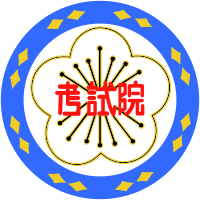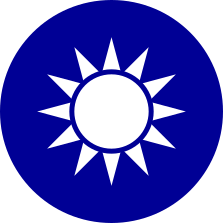Examination Yuan
The Examination Yuan (Chinese: 考試院; pinyin: Kǎoshì Yuàn; Wade–Giles: K'ao3-shih4 Yüan4) is in charge of validating the qualification of civil servants in the Republic of China (Taiwan). It is one of the five government branches ("yuans") of the Government of the Republic of China. Its members are appointed by the Executive Yuan and confirmed by the Legislative Yuan (formerly the Control Yuan before amended in Article 6 of the Additional Articles). Practically, it operates like a ministry of the Executive Yuan,[2] though its members may not be removed by the President or Premier. The Examination Yuan consists of 7 to 9 members who serve 4 year terms.[3]
| 考試院 Kǎoshì Yuàn (Mandarin) Kháu-sṳ Yen (Hakka) | |
 Logo | |
| Agency overview | |
|---|---|
| Formed | January 1930 |
| Jurisdiction | Republic of China (Taiwan) |
| Headquarters | Wenshan, Taipei |
| Agency executives |
|
| Website | www.exam.gov.tw |
| Examination Yuan | |||||||||||||||||||||||||||
|---|---|---|---|---|---|---|---|---|---|---|---|---|---|---|---|---|---|---|---|---|---|---|---|---|---|---|---|
| Chinese | 考試院 | ||||||||||||||||||||||||||
| Literal meaning | Court of Examinations | ||||||||||||||||||||||||||
| |||||||||||||||||||||||||||
 |
|---|
| This article is part of a series on the politics and government of the Republic of China |
|
|
|
|
|
|
|
Related topics |
|
|
As a special branch of government under the Three Principles of the People formulated by Sun Yat-sen, it may (retrospectively) be compared with the European Personnel Selection Office of the European Union or the Office of Personnel Management of the United States of America. The Examination Yuan is based on the old Imperial examination system used in Imperial China.
History
Mainland China
After the end of Northern Expedition in 1928, the Nationalist Government set up the preparatory office of the Examination Yuan in October 1928 in which the organic law was promulgated. In May 1929, the headquarters of the Examination Yuan was inaugurated at Kuankung and Yueh Fei Temple in Nanking. In January 1930, the Examination Yuan and its subordinates Examination Committee and Ministry of Civil Service were formally established. In December 1937, the headquarters was temporarily relocated to Chungking during the Second Sino-Japanese War. After the end of World War II in 1945, the headquarters was moved back to Nanking.
Taiwan
In January 1950, the headquarters were relocated temporarily to Taipei Confucius Temple in Taiwan after the Chinese Civil War. In December 1951, the headquarters were moved to Muzha District, Taipei. In March 1990, the Yuheng Building of the Yuan was inaugurated.[4] During the second revision of the Additional Articles of the Constitution of the Republic of China in 1992, confirmation powers of its members were transferred from the Control Yuan to the Legislative Yuan, and articles related to its role as a governing body of mainland China were abolished. In 2019, the Examination Yuan was reduced from 19 members to between 7 and 9, and terms were reduced from 6 years to 4 to coincide with presidential and legislative elections.[5]
Organizational structure
- Counselors
- Secretariat
- First Division
- Second Division
- Third Division
- Editing and Compilation Office
- Information Management Office
- Secretary Office
- Personnel Office
- Accounting Office
- Statistics Office
- Civil Service Ethics Office
- Petition and Appeals Committee
- Legal Affairs Committee
- Research and Development Committee[6]
Ministries
- Ministry of Examination (考選部)
- Ministry of Civil Service (銓敘部)
Commissions
- Civil Service Protection and Training Commission (公務人員保障暨培訓委員會)
- Public Service Pension Fund Supervisory Board (公務人員退休撫卹基金監理委員會)
See also
- List of Presidents of the Examination Yuan
- List of Vice Presidents of the Examination Yuan
- Government of the Republic of China
- Politics of the Republic of China
References
- http://www.exam.gov.tw/cp.asp?xItem=6257&ctNode=603&mp=5
- Huang, Yu-zhe (December 28, 2019). "Control Yuan must respect judges". Taipei Times. Retrieved May 20, 2020.
- "Tsai submits 11 nominees for Examination Yuan". Taipei Times. May 30, 2020. Retrieved June 11, 2020.
- http://www.exam.gov.tw/lp.asp?ctNode=607&ctUnit=169&baseDSD=7&mp=5
- Wang, Yang-yu; Kao, Evelyn (December 10, 2019). "Legislature passes revised law to shrink Examination Yuan". Central News Agency. Retrieved February 19, 2020.
- http://www.exam.gov.tw/cp.asp?xItem=9518&ctNode=611
External links
| Wikibooks has a book on the topic of: Annotated Republic of China Laws/Additional Articles of the Constitution of the Republic of China/Article 6 |
| Wikimedia Commons has media related to Examination Yuan. |